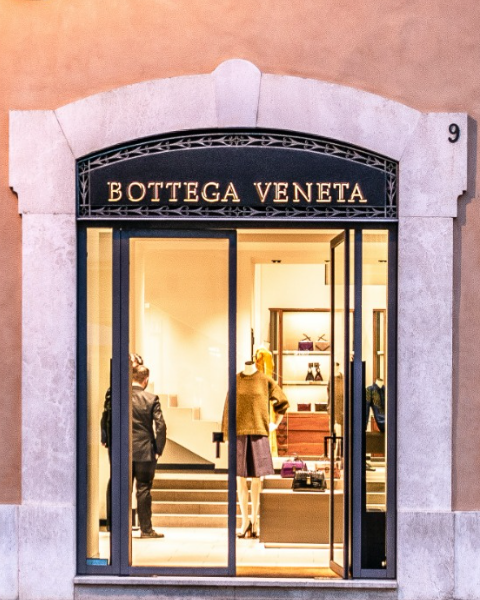“When your own initials are enough” – Bottega Veneta®
Brief Overview:
- Italian Luxury Fashion House
- Founder: Michele Taddei & Renzo Zengiaro
- Founded: 1966
- Innovations:
- The Intrecciato: The distinctive leather weaving design developed by and synonymous with the brand.
- Discreet no label design – Unbranded identity.
- Bottega opened a school: ‘Scuola Della Palletteria’ to train leather artisans.
- Simplistic, Craftsmanship, Understated & Minimalistic
Bottega Veneta Associated Quotes:
- “I like simple, I like quality, and I like less. Do I like a certain aesthetic? Yeah.” – Tomas Maier
- “I think every collection is always a move forward. It’s the same work – the process is always the same. The interesting thing is to try to achieve a certain nothingness.” – Tomas Maier
The History of Bottega Veneta®
Bottega Veneta was founded in 1966 by Michele Taddei and Renzo Zengiaro. The name translates to ‘Venetian Shop’ and was established by the two partners in Italy as a fine leather goods company. The brand soared in the ’60s and ’70s, and Bottega quickly gained a cult following due to the brand’s recognition of high quality, discreetness and craftsmanship.
However, fashion trends evolved, and it was time for excess and logo mania to be on trend. Bottega attempted to follow the trend, but their sales declined magnificently; Taddei and Zengiaro left, and the reigns of creative direction were handed to Taddei’s ex-wife, Laura Braggion.
Bottega debuted its first ready-to-wear collection in 1998 through the creative vision of then creative director Laura Moltedo and design director Edward Buchanan. Despite further changes in direction and leadership, Bottega Veneta ultimately failed to keep up with current fashion trends. Upon the entrance of Tomas Maier, who took over as creative director in 2001, the brand was on the verge of bankruptcy.
Bottega Veneta was not founded to be flashy or excessive. The brand’s identity revolves around ‘stealth wealth’ and quiet luxury hence the brand’s tag line “When your own initials are enough.” The brand initially didn’t use logos on designs but relied on fine craftsmanship to be how the brand is recognised and distinct from others in the luxury market. Tomas Maier understood that this is how Bottega gathered its initial popularity. Upon his appointment, he completely stripped any excess from the brand and returned the label to its minimalism identity and re-introduced the unique style that had garnered so much popularity: The Intrecciato, The distinctive leather weaving design developed by and synonymous with the brand today. To ensure the heritage of the design house was never forgotten again, Maier opened ‘Scuola Della Palletteria’, a school for craftsmen that would help artisans preserve the brand’s traditions. In 2018, Maier was replaced by Daniel Lee. Kering’s CEO, François-Henri Pinault, announced that tradition and craftsmanship were insufficient. Lee honours the design house’s quiet luxe traditions but also adds modern tweaks. Daniel Lee has continued the brand sans logo and very much infuses Intrecciato in a vast majority of the designs. He has introduced ‘the pouch,’ ‘stretch sandal,’ ‘cassette bag’, and many other well-recognised and popular Bottega designs. Lee left the post in 2021 and was replaced by Matthieu Blazy.
Signature Styles & Iconic Designs
‘The Intrecciato’
Intrecciato (Italian for intertwined) is the woven leather pattern synonymous with the house’s designs today. It is an intricate and complex process where slits are used, allowing for a high-quality weave pattern of immaculate craftsmanship. The technique was introduced by Bottega Veneta when they started (’60s). They had to use finer leather due to the inadequacy of their sewing machines when weaving leather (the machines were for ready-to-wear clothing, so the needles were not strong enough to go through thick leather for accessories). To combat the supple leather and ensure quality, durable designs, the house decided to cut the leather into strips and weave them together; this made for a strong weave that reinforced the supple leather. Intrecciato is still used across most Bottega Veneta designs.
The Cabat
The Cabat bag is one of the house’s most recognised and highly regarded handbags, and it was debuted by Tomas Maier when he joined Bottega in 2001. The Cabat uses a double intrecciato technique, woven entirely by hand. The bag is a sturdy tote bag that is completely unlined and seamless. The outside of the bag mirrors the inside, and there are no visible seams or joints. The bag has remained popular since its launch. It is a premium item as the house only releases about 500 of these bags annually, which are exclusively available in the brand’s boutique. Each bag has a detachable pouch with a gold label that Bottega calls a “number plate.” The number plate features the engraved words “Limited Edition,” item number out of the total number of units available.
The Pouch
The Bottega Veneta Pouch is an iconic Clutch bag designed by Daniel Lee. The bag quickly gathered a cult following, put the house back on the fashion radar and has since remained a fan favourite. The Pouch was inspired by and is a modern take on the clutch bag donned by Lauren Hutton in the film: American Gigolo (1980). The Pouch was announced as the fastest-selling bag in the brand’s history in Kering’s 2019 annual report. These are highly impressive stats, as the design was a part of Lee’s debut show in Bottega’s SS19 collection.
Bottega Veneta Biographies
Movies
- Bottega Veneta: Men, 2020
Books
- Bottega Veneta: When Your Own Initials Are Enough – Tomas Maier
- Bottega Veneta: Art of Collaboration – Tomas Maier





